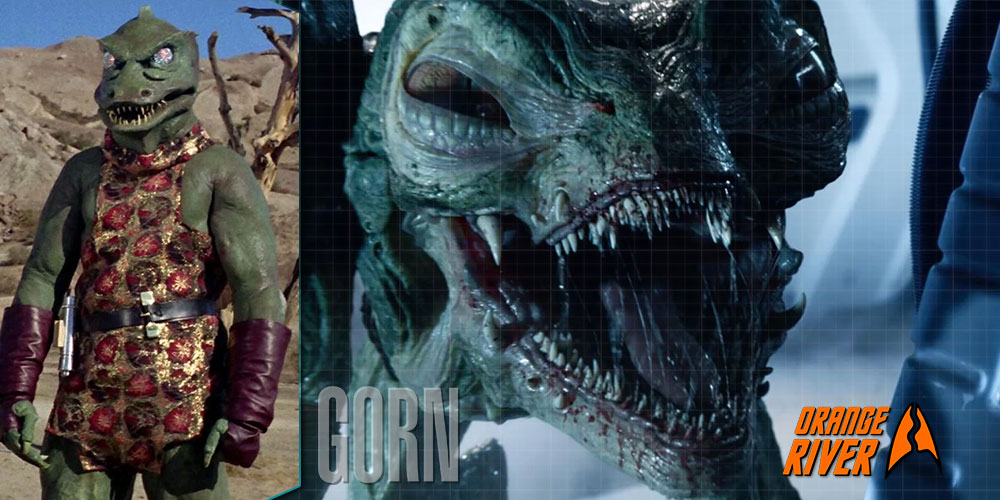The Gorn are one of the most recognizable alien species in Star Trek. First appearing in The Original Series episode “Arena,” the Gorn have, so far, just over a dozen canon appearances throughout the franchise, but their impact in popular culture has been substantial, nonetheless.
A bipedal reptilian race, the Gorn have butted heads with the Federation on multiple occasions. But by the 24th century, much like with the Klingons, relations with the Gorn seem to have cooled down. In the meantime, the Gorn have always represented a formidable opponent.
Despite their monstrous appearance and aggressive demeanour, they are cunning, intelligent, and technologically advanced. Today, I’d like to examine the biology, history, and culture of the Gorn, comparing them to our expectations about aliens in real life. I’d also like to explore how their relationship with the Federation has evolved over time. Let’s get started.
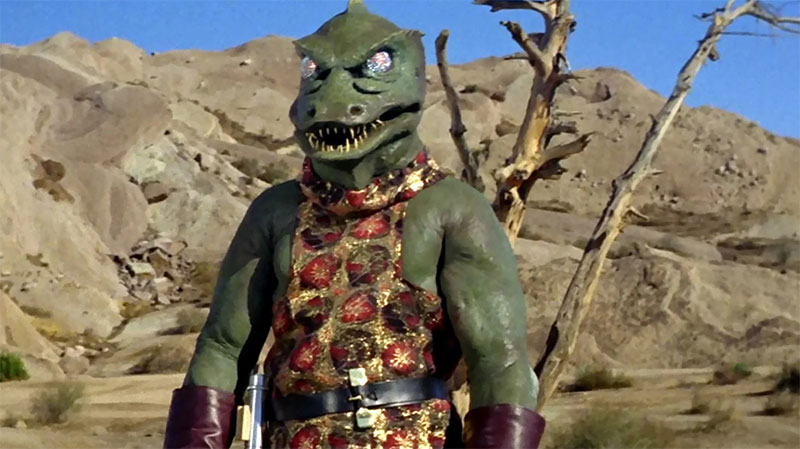
Origins and Early History
The Gorn’s interstellar government is called the Gorn Hegemony. Its domain includes a region of space called “the five systems,” referenced by Orion privateer Harrad-Sar in the Enterprise episode “Bound.”
However, Harrad-Sar says of the Gorn, “the less said about them, the better.” More information about the Gorn’s potential origins is revealed in the non-canon 2013 Star Trek video game, which is set in the alternate reality introduced in the 2009 movie. In this game, the Gorn are said to have originated from another galaxy which they have colonized under the banner of the Gorn Armada.
The Gorn reach the Milky Way via a wormhole and begin expanding into the Beta Quadrant, just outside the borders of both the Federation and Klingon Empire. Much like in other non-canon sources, this game and subsequent IDW companion comics emphasize that the Gorn are not one species, but rather, an alliance of genetically similar reptilian aliens.
One of these factions which have settled on the planet Parthenon 559 is depicted as rebelling against the Gorn Armada, suggesting Gorn are not of one mind when it comes to politics. Either way, the existence of these multiple species, which other sources additionally depict as strict castes, is used to explain the disparities between different canon depictions of the Gorn.
The videogame Starfleet Command explains that Gorn society is organized into a hereditary monarchy. Gorn mythology speaks of a Mistress of Fertility, S’Yahazah, who saved young Gorn eggs from being devoured by a figure called “The Great Father.” Clearly, this is a reference to the Greek goddess Rhea saving Zeus from being devoured by Cronus.
Star Trek Online expounds upon Gorn history by speculating they may share a common ancestor with the Saurian species, dating back about 15,000 years. This ancestor race may have inhabited planets in the Kassae system, some 40-60 light-years from Earth. Other sources cite Gorn space travel as far back as thousands or even millions of years ago, and between these various accounts, there’s no consensus as to whether the Gorn evolved on the same homeworld or separate homeworlds.
All of this also seems to contradict Gorn activities beyond the Milky Way Galaxy, but ultimately, there’s no telling where they first came from. They could have originated in the Milky Way or another galaxy first, travelling between the two via a mechanism like, say, the Mycelial Network. In any case, what’s clear is that they have achieved warp travel by the 22nd century and developed a violent reputation among various other Beta Quadrant civilizations.
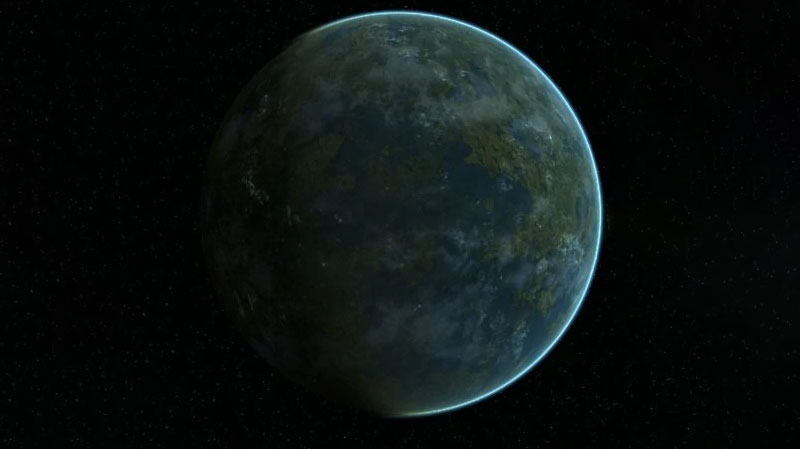
New Homeworld?
We’re never explicitly told what kind of star the “new” Gorn homeworld orbits, though in beta continuity, it’s the ninth planet in a triple star system consisting of three K-type orange stars.
While the habitable zone around a K-type star, a type of star usually cooler than the sun, is about 60% the size of Sol’s habitable zone, the triple nature of the star may mean the ninth planet is further out in a tightly packed system.
K-type stars’ habitable zones are also generally stable as they emit less light in the ultraviolet portion of the spectrum, which normally has severe effects on DNA molecules. It’s also worth noting that planets orbiting multiple stars in a “P-type” orbit are generally stable if they orbit at least 2-4 times the distance separating the stars themselves.
The name “Tau Lacertae” for the star system is thrown around by various non-canon sources, Lacerta being a real-world constellation whose name means “lizard” in Latin. GET IT??? And tau, of course, is the nineteenth letter of the Greek alphabet.
But there is no such star called “Tau Lacertae.” And there are no notable K-type triple systems in Lacerta. But we can gather that even if the Gorn didn’t originally evolve on Tau Lacertae IX, they no doubt selected it because of its environment. The planet, also called Gornar, has a surface gravity of 1.4g—implying it has a higher mass, radius, and possibly density compared to Earth—and is largely covered in tropical jungles and swampland. It has two Class D moons, which would have a major influence on the planet’s tides.
The Gorn homeworld’s average surface temperature is likely higher than Earth’s, which would create a suitable climate to support the biology of a cold-blooded reptilian species. And indeed, their cold-blooded nature isn’t their only connection to the Terran order of animals…
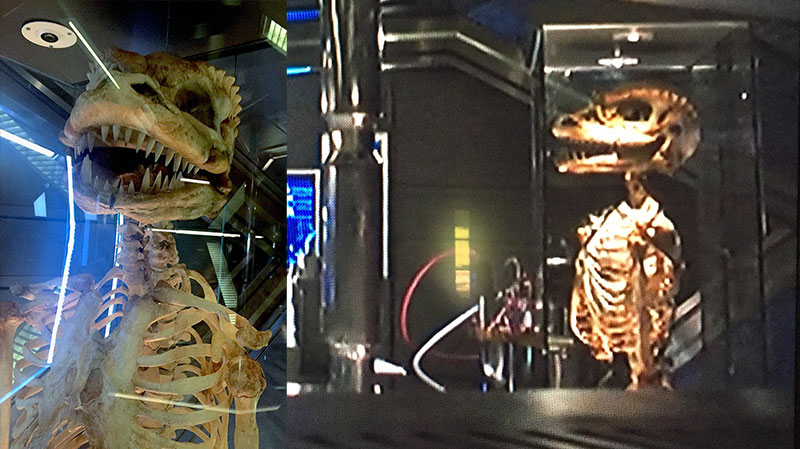
Biology Overview
Much like many Earth reptiles, particularly crocodiles, the Gorn possess scaly green skin, red blood, simple earholes with no external cartilage, and vicious claws. They also have mouths full of sharp teeth unsuitable for chewing—indeed, the teeth of reptiles are generally undifferentiated in size and shape compared to mammals, whose teeth are more specialized.
Gorn eyes are often depicted as silvery and faceted, much like the compound eyes of insects, suggesting a considerably different evolutionary path. Indeed, compound eyes have rather poor image resolution but possess a larger viewing angle and the ability to detect fast movement. Still, others have typical reptilian eyes with slit pupils, like the Tholian-employed slavemaster Slar in the Enterprise episode “In a Mirror, Darkly.” They have at least two genders, male and female.
Gorn has an average height of approximately two meters and tends to be many times stronger than most humanoids. Adult Gorn is slower and less agile than humans on average but possesses more durability and stamina. Unaided by the universal translator, their language sounds to most humanoids as a series of clicks and growls. And as far as their lifespan, one source indicates they can live for up to three hundred years. This brings me to the discussion of the Gorn’s life cycle…
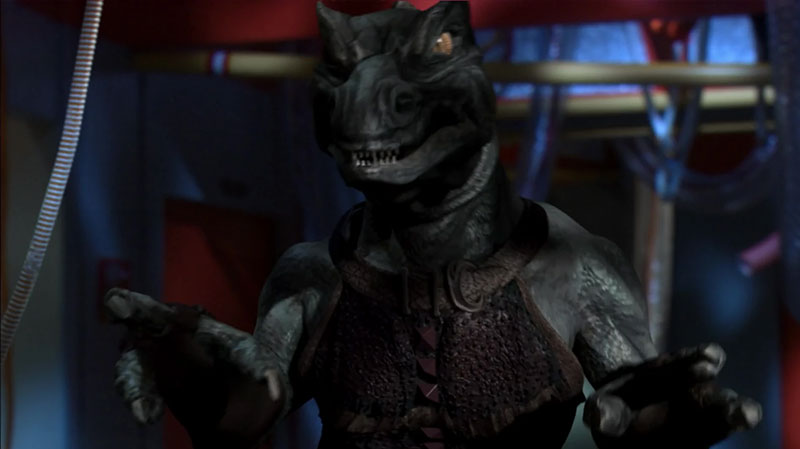
Life Cycle
In the Gorn’s earliest appearances, their growth and maturation cycle has never been explored deeply—or, actually, at all. Star Trek Into Darkness has an offhand line of dialogue indicating Gorn can become pregnant with live young, a phenomenon in nature known as viviparity.
This is not so unusual for a reptilian being, as some Earth snakes and lizards don’t lay eggs. Caesarean sections may be necessary to deliver Gorn children in such a way, with births of up to eight children at a time known to have occurred. The infants are apparently highly aggressive even when born in this manner. In season one of Star Trek: Strange New Worlds, however, we are treated to a much different, more thoroughly detailed explanation as to how the Gorn reproduce. And indeed, this is just one of a number of things about the Gorn that are a notable departure from previously established canon…or so it might seem at first.
In the fourth episode of Strange New Worlds, “Memento Mori,” the character La’an Noonien-Singh recounts how, as a child, she escaped from a Gorn breeding planet. On these planetary nurseries, Gorn deposit sentient beings for use as breeding sacs or to be hunted as food by Gorn hatchlings.
The adults will periodically return to these planets to harvest their young. As we see in the series’ ninth episode, “All Those Who Wander,” Gorn hatch from parasitic eggs that incubate inside humanoid hosts. This is in contrast to the previously mentioned viviparity—pointing towards different methods of reproduction and/or the existence of, once again, different species of Gorn.
Their maturation cycle depends on the species of the host, lasting months in some cases but days in others. When ready, hatchlings will rip their way violently from the host’s body in a clear homage to the xenomorphs from Alien.
Newly emerged Gorn are white in colour—they become green as they feed voraciously and grow rapidly in size, moulting their skin along the way. Both the eggs and hatchlings are biologically invisible to sensors—rather conveniently—and despite their bestial nature, hatchlings can prevent themselves from being sensed telepathically.
Gorn hatchlings are quadrupedal, and they are exceptionally fast and strong in clear contrast to their adult forms. Not only are they uncontrollably aggressive towards other life forms—they are also aggressive towards members of their own species. Competing for dominance, only the strongest and smartest survive. Juvenile Gorn develops ducts that enable them to spit venom, which can infect additional hosts with eggs. As some have speculated, many of these other advantageous traits could indeed be the result of genetic engineering.
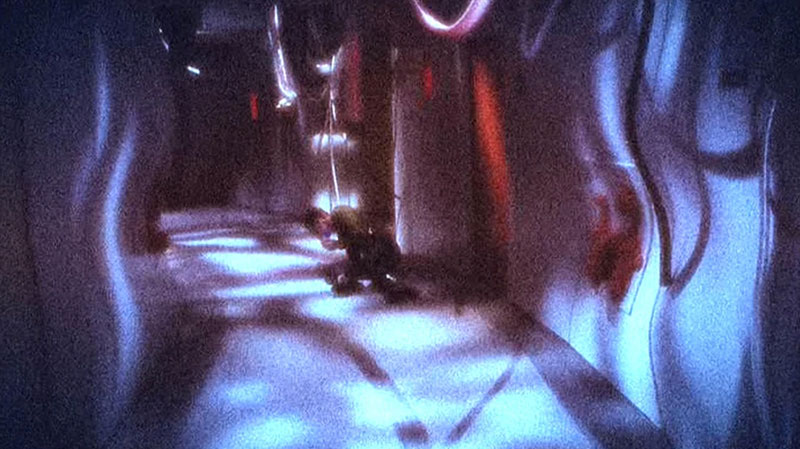
So, how can this more fearsome depiction of the Gorn be reconciled with their other appearances throughout Star Trek? Well, the most straightforward answer is that Gorn hatchlings are simply more rambunctious and appear to, well, mellow out as they mature. Of course, “mellow out” only in a comparative sense. Also, keep in mind that the “intelligence” of human babies is nothing remarkable, being on average slightly under that of an untrained domestic dog.
“Trained” dogs are ones that work for the police, the armed forces, on movie/TV sets, as guide dogs, shepherds etc. And feral dogs are, logically, somewhat more intelligent than most regular, coddled pet dogs, simply because they must be due to their unfortunate circumstances. As humans mature, of course, our IQ goes up as we train our minds by learning things and practising new skills.
Something that should be further emphasized as well is that many animals’ “final forms” are quite drastically different from their infant or even adolescent stages. I talk about one type of biological transformation, metamorphosis, in detail in my video about the Metroids from, well, Metroid…another species that Strange New Worlds’ lil’ baby Gorn is reminiscent of. While we don’t exactly know how many times a Gorn moults its skin, this process is just one example of how the Gorn metamorphose during its life cycle.
And their assumption of an upright posture later in life is, once again, perfectly in line with the maturation of an intelligent lifeform. Besides humans, bipedal locomotion is common among birds, the descendants of avian dinosaurs—and as I also demonstrated in my video about the Chozo from “Metroid,” birds are some of the smartest nonhuman terrestrial animals, another indication that the evolution of a sapient reptilian species is more plausible than one might think.
Plus, if you’re looking for further evidence connecting the familiar Gorn with their quadrupedal counterparts, let’s not forget Lorca had a Gorn skeleton as part of his “menagerie” aboard the starship Discovery—a show that directly predates Strange New Worlds and which shares the show’s overall design language.
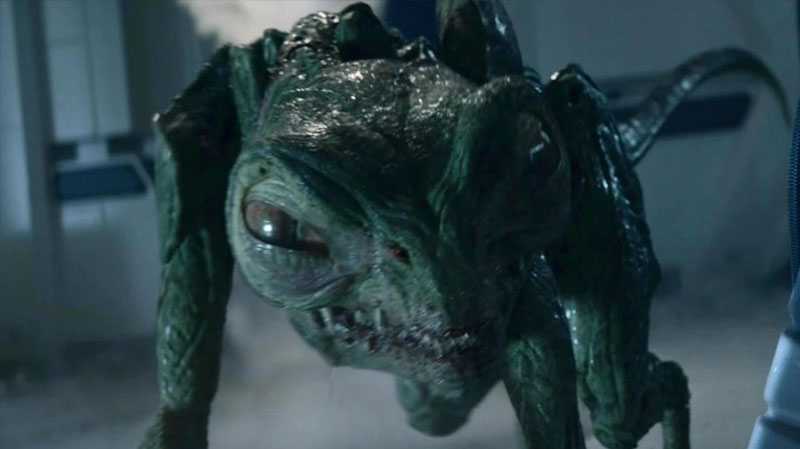
Federation-Gorn Relations
Regardless, in Strange New Worlds, Gorn is referred to on occasion as “monsters.” Humans are merely prey to them, La’an emphasizes, and she dismisses the idea that they can ever be reasoned with—some things in the universe, she says, are simply evil. Of course, this is through the lens of one character’s traumatic childhood experiences.
It should be noted that such a roughshod, antagonistic approach to dealing with an enemy is not entirely out of character for a Starfleet crew in the mid-23rd century, and it’s up to the discretion of individual captains as to how to deal with such matters. Besides, we do ultimately see that, evidently, La’an isn’t correct that the Gorn can’t be reasoned with…more on that later.
In terms of the Federation’s other dealings with the Gorn, despite multiple unofficial contacts between the two powers by 2259, the Gorn have never been listed as “officially” encountered. This is primarily because the Gorn hardly leave survivors.
In accordance with ritual, when Gorn hunt captives for sport on their breeding worlds, one survivor is spared and placed in a life raft jettisoned into space. The survivor is not expected to live, though La’an obviously did.
The first “official” contact between the Federation and the Gorn does occur in 2267 when the Gorn attack a Federation colony on the planet Cestus III. The Gorn view their attack as a preemptive move since they regard Cestus as part of their own territory. The USS Enterprise pursues a Gorn starship into unexplored space, where both ships are immobilized by the super-advanced and mysterious Metrons, who pit Captain Kirk and the Gorn captain against each other, against their will, in a contest of strength and ingenuity to the death.
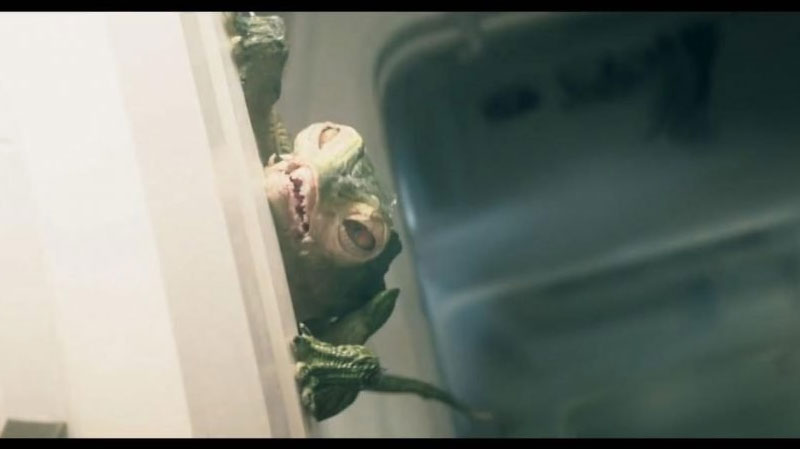
Kirk spares the brutish Gorn’s life after Kirk is victorious, and the calculating but high-principled Metrons send both captains back to their respective ships and transport the Enterprise light-years out of the area.
Given how intelligent the Gorn are, they are surely keenly aware of the Federation’s perception of them up to this point. So, it’s likely that this very encounter in “Arena” was an instrumental stepping stone in the thawing of Federation-Gorn relations as both cultures began to appreciate each other’s perspectives and moral systems more fully.
This is why, by the 24th century, the Cestus conflict is more or less resolved…the Federation colony has been rebuilt, and Benjamin Sisko speaks of the Pike City Pioneers baseball team that hails from this planet’s capital. This doesn’t mean the Federation and the Gorn have to be best buds, but once again, like the Klingons, open hostilities have apparently been reduced to a minimum.
And even more has been done in recent Trek instalments to, in a word, further “humanize” the Gorn. In Lower Decks, we see a Gorn wedding reception, and a Gorn chef works at a restaurant on Federation Starbase 25.
A Gorn is even referenced as having attended William T. Riker’s bachelor party in an omitted line of dialogue from the first draft script of Star Trek: Nemesis. While admittedly a lot of work must be done, both in-universe and out-of-universe, to bridge this more peaceful depiction of the Gorn with their depiction as loose analogues to Alien’s xenomorphs, the point is, the groundwork has already been laid for such a transition. So, no, Ms Noonien-Singh, the Gorn can be reasoned with. Much like has happened with the Romulans and multiple other antagonists in Star Trek, given enough time, an enemy really can become an ally—even a friend.
If you want to support my work even further, becoming a patron at patreon.com/orangeriver is a great way to do so.
Watch The Latest Video By Orange River Media Below
Thank you all so much for watching. I know that the topic of this video isn’t exactly new news, but I did want to offer my thoughts on it. If you enjoyed this video, be sure to leave a thumbs up down below and don’t forget to share it.
That’s all I have for this week…live long and prosper…
You can find Orange River Media at the links below
- YouTube: https://www.youtube.com/orangeriver
- Twitter: https://www.twitter.com/orangerivernw
- Instagram: https://www.instagram.com/orangeriver.nw
- Facebook: https://www.facebook.com/orangerivernw
- Patreon: https://www.patreon.com/orangeriver

